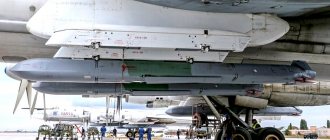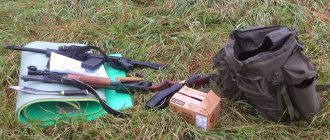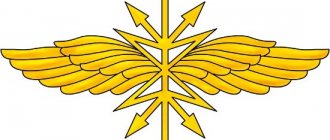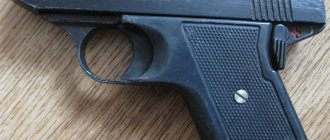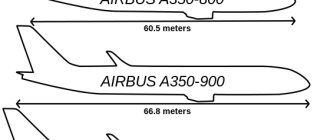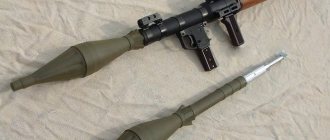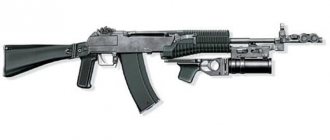Russian UAV "Forpost" over Syria
UAV "Forpost"
A Russian system created on the basis of foreign components, primarily Israeli-made.
Photo: IA “ARMS OF RUSSIA”, Alexey Kitaev
In April 2009, Russia purchased 12 BirdEye-400, I-View Mk150 and Searcher II drones from Israel for a total amount of $53 million. Later, a contract was signed for the supply of another 36 drones worth one hundred million dollars, and in April 2010 It became known about the purchase of another 15 UAVs from Israel. On October 13, 2010, it was reported that the Russian corporation Oboronprom had entered into a contract with IAI for the supply of components for the assembly of drones.
Photo: IA “ARMS OF RUSSIA”, Alexey Kitaev
Already in 2011, the Forpost UAV was demonstrated at the arms exhibition in Nizhny Tagil and at MAKS-2011, it was presented by the Ural Civil Aviation Plant OJSC. In 2011, the Russian Ministry of Defense issued a contract to UZGA for the supply in 2011-2013 of 10 complexes with the Forpost UAV with a total value of 9.006 billion rubles.
The assembly of the Forpost UAV (IAI Searcher Mk II) for the Russian Ministry of Defense was carried out at the Ural Civil Aviation Plant OJSC. Tests of the Forpost UAV (IAI Searcher Mk II), assembled at the Ural Civil Aviation Plant OJSC for the Russian Ministry of Defense, were carried out at the Salka flight base near Yekaterinburg in December 2012.
The Forpost unmanned aerial vehicle complex is designed to search, detect and identify ground objects. It carries a modular electro-optical payload.
The device performs a remotely controlled flight from the ground in autonomous mode or according to a preset program, and also navigates with the support of a ground control station and a differential global positioning system.
Photo: IA “ARMS OF RUSSIA”, Alexey Kitaev
Transmits data on flight parameters and payload status to the ground control station. The UAV maintains constant communication with the ground control station via duplicate channels in full duplex mode.
The Outpost, like the Searcher II prototype, is launched from an ordinary unprepared takeoff site. The Israeli prototype can take off using a pneumatic catapult or JATO rocket boosters. The long flight time makes this UAV a convenient means of patrolling and control. The UAV is equipped with a MOSP (Multimission Optronic Stabilized Payload) TV/FLIR complex with a real-time transmission system for GCS or an EL/M-2055 SAR/MTI reconnaissance container. It can also be equipped with a 1200 mm color CCD video camera. Universal in terms of launch method and economical.
At the joint operational exercise “Shield of the Union-2011”, which took place from September 16 to 22, 2011 at the Ashuluk training ground (Astrakhan region), the use of Israeli-made IAI Searcher Mk 2 unmanned tactical reconnaissance aircraft, appearing in Russia under the designation “Outpost”, was observed. " In particular, a UAV with tail number “785” was filmed on the ground, and “788” in the air.
The Ural Civil Aviation Plant (Ekaterinburg), as part of the state defense order for 2013, supplied the Russian Ministry of Defense with more than 10 aviation complexes with unmanned aerial vehicles (UAVs) “Forpost”, a serial model of which was demonstrated at the Russia Arms EXPO-2013 arms exhibition in Nizhny Tagil.
“At the previous international exhibition of weapons, military equipment and ammunition, Russia Arms EXPO, we demonstrated a sample of the Forpost UAV that we had just assembled, but it had not yet been tested. At the current exhibition, we are presenting a serial unmanned aerial vehicle on the ground and in the air, which will be delivered to the troops immediately after the exhibition. The customer of these complexes is the Ministry of Defense of the Russian Federation. We have already delivered more than 10 such complexes this year,” Vadim Badekha, general director of the Ural Civil Aviation Plant, told Interfax-AVN.
Photo: IA “ARMS OF RUSSIA”, Alexey Kitaev
He recalled that serial production of the Forpost UAV began in the middle of last year.
“This device is based on technologies that we received from the Israeli company Israel Aerospace Industries LTD (IAI) under a previously concluded contract. At the first stage, the Ministry of Defense bought ready-made systems from Israel, at the second, Israel transferred technology to us to organize full-cycle production in Russia. As part of the second stage, we mastered the production of an unmanned complex in Yekaterinburg at our plant,” said V. Batekha.
In April 2020, a tender “Performing work on technical supervision of the operation of complexes with unmanned aerial vehicles “Forpost” and “Zastava” for the needs of the Ministry of Defense of the Russian Federation” was published on the government procurement website.
Photo: IA “ARMS OF RUSSIA”, Alexey Kitaev
The documentation lists the military units of the RF Armed Forces that are armed with these aircraft, indicates what work needs to be done with these UAVs (in particular, replacement of air and electronic equipment, replacement of the automatic landing system, replacement of the landing gear system and UAV system, replacement of engine components of the cooling truck, replacement of components engine, replacement of UNSU components, replacement of control and measuring equipment).
In total, in 2020 it is required to service 10 Forpost unmanned aerial vehicle complexes and 27 Zastava unmanned aerial vehicle complexes:
- military unit 20924 (Kolomna, Moscow region) – 2 “Forposts”, 1 “Zastava”
- military unit 30866 (Chernyakhovsk, Kaliningrad region) – 2 “Outposts”
- military unit 44936 (Budennovsk, Stavropol Territory and Mozdok, Republic of North Ossetia) – 2 “Outposts”
- military unit 49324 (Severomorsk, Murmansk region) – 2 “Outposts”
- military unit 69262 (Elizarovo settlement, Kamchatka Territory) – 2 “Outposts”
The cost of spare parts for technical supervision during operation of Forpost unmanned aerial vehicle systems should not exceed RUB 5,243,568.23. (including VAT) for 1 complex of unmanned aerial vehicles.
Photo: IA “ARMS OF RUSSIA”, Alexey Kitaev
Tactical and technical indicators
| System range, km: | when operating an omnidirectional antenna – 150; when operating a directional antenna - 250 |
| Weight, kg: | maximum takeoff - 454; dry – 325; maximum payload – 100; maximum fuel weight - 99 |
| Length, m | 5,85 |
| Wingspan, m | 8.55 |
| Height (excluding antenna), m | 1,4 |
| Engine | Jabiru 2200 |
| Engine power, hp | 80 |
| Speed, km/h: | maximum - horizontal flight - 204; working - 126...148; stall — (closed 0°) – 98, (closed 38°) – 88 |
| Practical ceiling, m | 5797 |
| Maximum flight duration, hour | 17,5 |
| Take-off distance, m | 250 |
Who are the best and most important drone companies in the world?
In this article, we will look at information about the leading drone manufacturing companies in the world today. From market leaders DJI and Yuneec to new companies producing interesting drones like UVify.
Due to the growing popularity of quadcopters, more and more companies are entering the market, especially manufacturers of other RC vehicles.
When starting out, some drone manufacturers buy generic products and attach their own logos, which in some cases results in multiple companies selling the same product.
The purpose of this article is to introduce you to the best and most reputable companies on the market, with a strong focus on consumer drones.
The drone market has different segments with different sets of requirements from buyers. Segments include:
- Toy drones or quadcopters for beginners
- Quadcopters for various types of filming
- Commercial drones
- Racing drones
Foreign Media 11/13/2017 Belarusian News 10/17/2017 Project Syndicate 10/02/2017 Le Monde 09/07/2017 Based on available information, it is likely that this aircraft will be used for surveillance and reconnaissance purposes, and could be used in moderately contested airspace or , perhaps in a maritime setting.
It is likely that in the future, based on this drone, developers will be able to create devices capable of overcoming access/area blocking systems. Russia will need time and a lot of money to develop an unmanned attack aircraft with a jet engine. “They are looking to quickly develop new strike-capable UAVs, and this new drone could be a test case for that platform,” said Sam Bendett, a researcher at the Center for Naval Analysis who specializes in Russian military robotics. “It could become a test model for a new high-speed device.” After all, the US is also developing this type of platform.”
It may well be several years before Simonov's new drones take off, but fierce competition for the contract proves that Russian industry is slowly catching up with the West in certain areas.
“This will happen in a few years - the Simonov design bureau has just signed a contract, so the prototype will not appear for a few years,” Bendett said. “This design bureau has surpassed its rivals such as the bureaus of Tupolev, Yakovlev and Kronstadt - the latter has just introduced its Orion drone - that is, we are seeing serious competition in the Russian UAV industry.”
The main task now is to develop an experimental platform, but over time this could lead to the creation of a combat-ready aircraft. “Subject to sufficient funding and high-quality work of the designers,” Bendett noted. “After all, Simonov’s bureau is also currently working on the Altair reconnaissance and strike UAV, and they are already behind schedule and already over budget.”
Bendett is confident that Russia will be able to create a high-speed unmanned attack aircraft and that it is just a matter of time. “I’m confident that Russia will get its high-speed UAVs—the question is when,” Bendett said. “The government pays great attention to such projects, so it is expected that a future working prototype will be released before 2020-2025.”
If Russia is able to create a combat-ready unmanned strike aircraft, it will significantly expand Moscow's capabilities in the field of intelligence, surveillance and reconnaissance, as well as in countering anti-access systems. Moreover, it will help significantly increase the potential of Russian conventional strategic deterrents, solving the problem of targeting and effectively delivering a strike.
InoSMI materials contain assessments exclusively of foreign media and do not reflect the position of the InoSMI editorial staff.
Technologies in the production of quadcopters
Perhaps the biggest breakthrough in consumer drone technology has been the classic four-rotor model for most quadcopters. This design is the de facto standard for consumer drones as we know them today.
Not only has the level of technology advanced rapidly, but the cost of technology has decreased very quickly. This has led to the availability of drones with advanced sensors and stabilized cameras for less than 6,000 rubles!
A number of major manufacturers - such as Yuneec, Parrot and DJI - bring relevant technological expertise to bear in related industries.
For example; Yuneec is one of the most innovative and largest companies with expertise in electric aviation, Parrot has extensive experience in producing high-quality wireless products, and market leader DJI has expertise in handheld camera stabilization technology.
Some other manufacturers who do not have the relevant technological expertise simply copy existing technologies and designs from leading drone companies. There's no shortage of copycats in the drone market, so we'll highlight the best companies to watch.
“The Perfect Killer”: a new electromagnetic gun has been created in Russia
Sources in the military-industrial complex of the Russian Federation reported: the range of guaranteed destruction of targets with prototypes of Russian electromagnetic guns has reached 10 kilometers, writes military observer Alexander Khrolenko.
This means that in the line of sight, high-tech enemy air and ground weapons can be instantly turned into a pile of scrap metal - due to the burning of components of control and aiming equipment by an electromagnetic pulse. The silent shot lasts milliseconds and there is no fire, smoke or recoil. It is impossible to identify the positional area of the EM gun using standard radar or satellite reconnaissance means.
Previously, the range of the EM gun reached three kilometers. Field tests of a new type of weapon have been going on since 2020, the guns successfully “burn” drones in the air and various devices on the ground.
Protection is provided for Russian combat electronics from the effects of “friendly fire” from the EM gun. Thus, specialists from the Ruselectronics holding previously created a ferrite fiber capable of protecting the electronic devices of modern armored vehicles, anti-aircraft missile systems and aircraft from the effects of enemy electronic warfare (EW) weapons.
The timing of the adoption of the new EM gun for service has not been specified, and yet Russia has come very close to this, the success is obvious. Today, prototypes are capable of hitting enemy UAVs, helicopters and cruise missiles at a considerable distance.
© Sputnik / Dmitry Vinogradov
“Caught on video”: with what weapons in Syria Russia surprised the whole world
It was as an air defense weapon that the new gun set a record - it “burned” a training air target at a distance of 10 kilometers. If the range can be increased to 20 kilometers, then modern combat aircraft (in altitude) will also be targeted. I believe that new achievements of the Russian defense industry in this area will not be long in coming. Electronic weapons based on new physical principles are already being used by the Russian army; Sputnik recently talked about the Listva remote mine clearance machine.”
EM guns on the front line
Weapons based on electromagnetic radiation technology are close in principle to electronic warfare (EW) systems. Instead of gunpowder and metal, the Russian EM gun uses high-frequency radiation energy.
Damaging electromagnetic radiation travels at the speed of light. The problem remains the huge energy consumption for each shot, but technology is constantly developing.
In the future, EM guns can be based on heavy 6th generation unmanned fighters, ground forces equipment and naval ships. If one day on the battlefield, for no apparent reason, the enemy’s planes and helicopters, drones, cruise missiles, tanks and other armored vehicles “fail,” it means they are in the sights of new warfare technologies.
The EM gun is considered a non-lethal weapon - it destroys electronics, but spares manpower. Hard electromagnetic radiation is dangerous to human health and can affect the nervous, immune, and other systems of the body. And yet, if an EM pulse “burns” the microcircuits and stops the engine of a manned aircraft, the pilot is doomed - the catapult will not work either.
Electromagnetic weapons are a whole range of tools designed to work in specific sectors. A magnetic field can be used to impart initial velocity to a projectile, as an alternative to gunpowder in classical artillery (railgun gun). In Russia, priority development has been given to electronic warfare systems and electromagnetic bombs capable of disabling all enemy radio and electronic equipment within a radius of 4 km, that is, leaving troops without communications and control, turning units into unorganized crowds. The EM gun is a new high-tech component of victory.
Interestingly, the idea of an electromagnetic gun was born simultaneously in Russia and France during the First World War. It is based on the works of the German researcher Johann Carl Friedrich Gauss, the author of the theory of electromagnetism. The idea was ahead of its time and did not find practical application in military equipment: the French model accelerated a 50-gram projectile to a speed of 200 m/sec, and was frankly outperformed by conventional artillery.
© Sputnik / Andrey Stanavov
“NATO will be surprised”: what the new Russian fighter will be armed with
The Russian project of a “magnetic fugal” gun remained in the drawings. The renaissance of ideas for electromagnetic weapons began at the beginning of the 21st century. In 2011, Artsimovich's railtron was successfully tested in the laboratory of the Shatura branch of the Joint Institute for High Temperatures of the Russian Academy of Sciences. The electromagnetic gun fired very small projectiles, but these “peas” with electromagnetic acceleration turned steel plates in their path into plasma. Five years later, Russian specialists accelerated matter to almost the first cosmic velocity, and have come a long way to the present day.
Partners are falling behind
Electromagnetic gun projects are being carried out by the USA, Israel, Türkiye, France, and China. Yet none of these countries has achieved the ten-kilometer effective range of “high-frequency fire.” For example, last summer the US Navy tested a railgun gun with a projectile velocity of about 2041 m/sec. Note that this solid-state ammunition (not an electromagnetic pulse) still did not exceed the maximum projectile speed of modern gunpowder artillery - 2500 m/sec. For future wars, the acceleration is clearly insufficient.
A railgun is a type of electromagnetic gun, the main elements of which are a power source, switching equipment and two electrically conductive rails ranging from one to five meters in length. The shot occurs at the moment of applying high voltage due to the interaction of plasma energy (combustion of a special insert) and the electromagnetic field. The Americans have been conducting laboratory tests of a 475-mm railgun gun (developed by General Atomics and BAE Systems) since the early 2000s, but success is not obvious.
A projectile weighing 23 kg leaves the barrel at a speed of about 2200 m/sec and can cause enormous destruction. It is unknown where and how far he flies.
The railgun gun in the US Navy faced an unenviable fate. Due to the resource of several dozen shots and the huge energy consumption, they abandoned the idea of \u200b\u200bplacing it on the advanced American destroyer Zumwalt. A ship cannot be a victim of its own weapons, and the use of an EM gun implied the disabling of almost all of the destroyer’s electronics, including air defense and missile defense systems. Experts from the US Naval Institute eventually proposed using Zumwalt-class “super-destroyers” only as command ships. Research continues. In the field of high-tech weapons, leading countries clearly lag behind Russia
